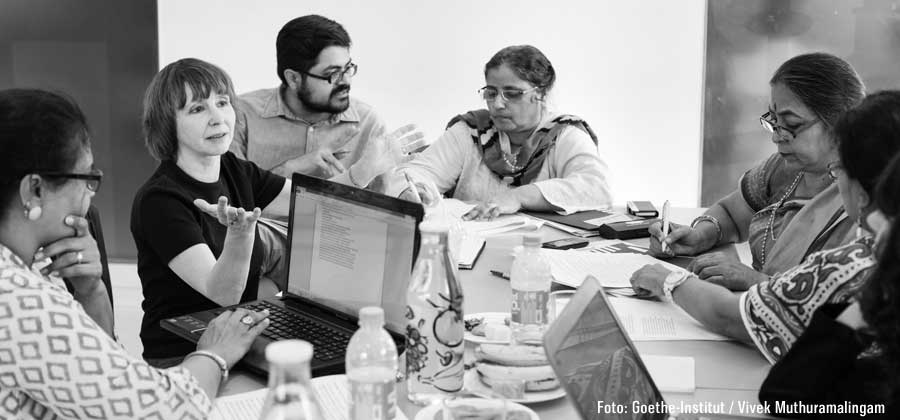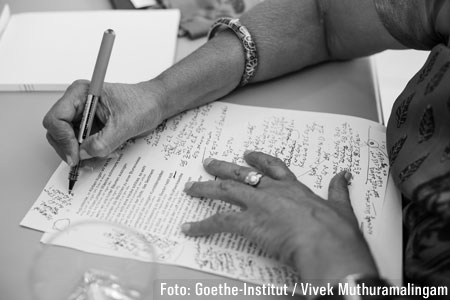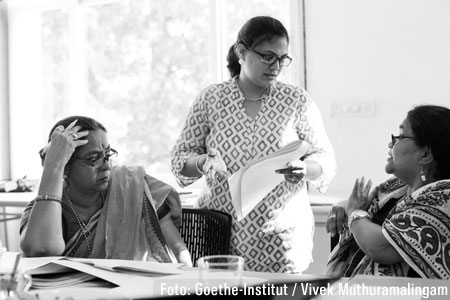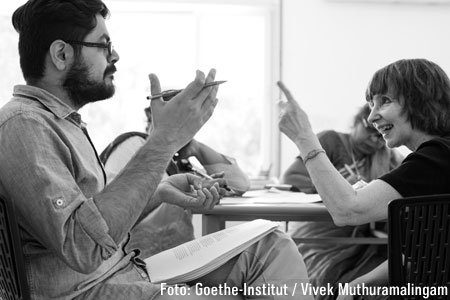Stringing words in the Pearl City – Hyderabad encounter


Indian poet Jeet Thayil had a skip on his step the second morning of the Poets Translating Poets encounter in Hyderabad. He and his fellow Anglophone Indian poet, Sridala Swami, had spent much of the first day with German poet Sylvia Geist in a process that Jeet called “Inspirational”.
They caught the wisp of magic in each other’s poems, used it to open doors to a new world and bring new light into their own. From this process emerged a resolve to not just translate the other’s poetry, but also rework their own poems. They both saw their own old poems emerge differently in this encounter and decided to rework their poems for fresh publication. Jeet said that he would use the new version for the next publication. There was something that had clicked into place. “There was harmony. There was nothing essential that you needed to explain to each other,” said Sylvia.While words were being strung together in a translation necklace of familiar Anglophone-German contexts, on the other side, two completely unfamiliar languages were bobbing their heads across a new horizon. Renowned Telugu and Urdu poets Jayaprabha and Jameela Nishat nudged Buddhas and Burkhas of other worldly verses into the pages of German poet Tom Schulz.
 This was Project PTP’s eighth encounter, and one of its most unique as it featured German and two Indian languages that have grown to become native over the last millennium – Urdu and English. The juxtaposition of these linguistic contexts threw some surprising features that saw the smuggling of various poetic forms and phrases in all its glory and fury, and through an intense encounter laid bare the dominance of global languages such as English.
This was Project PTP’s eighth encounter, and one of its most unique as it featured German and two Indian languages that have grown to become native over the last millennium – Urdu and English. The juxtaposition of these linguistic contexts threw some surprising features that saw the smuggling of various poetic forms and phrases in all its glory and fury, and through an intense encounter laid bare the dominance of global languages such as English.
Urdu, Englisch, Telugu and Deutsch
 The Indian subcontinent boasts of linguistic diversity that is perplexing – India alone has 28 official languages with over 1200 dialects. A project of the size of PTP had a tricky task ahead to balance these languages with not just the wealth of its literature, but also with infrastructure and organisation support from other Goethe-Instituts and Zentrums and finding the right interlinear translators with a masterly grasp of these languages and German.
The Indian subcontinent boasts of linguistic diversity that is perplexing – India alone has 28 official languages with over 1200 dialects. A project of the size of PTP had a tricky task ahead to balance these languages with not just the wealth of its literature, but also with infrastructure and organisation support from other Goethe-Instituts and Zentrums and finding the right interlinear translators with a masterly grasp of these languages and German.With the Goethe-Zentrum in Hyderabad as one of the encounter partners, the choice to include three distinct languages was a nuanced one. Hyderabad, now the capital of Telangana, has been the capital of a State with a Telugu-speaking majority. Urdu being the second-most spoken language in the city, made for obvious choices for Telugu and Urdu poetry as the two encounter languages. English, an undeniably important language of the subcontinent, also found room in this encounter bringing a unique flavour to the entire experience.
The complicated construct of linguistic pluralism in India was laid bare in this encounter. The German poets moved from translating the familiar Roman script and cultural contexts of the Anglophone poets to the completely unfamiliar contexts, scripts and sounds of Telugu and Urdu.
A complete surrender
Each poet sought to prepare for the world they were entering or letting one into. Jayaprabha, for instance, was conscious of the complexity of dealing with an alien language. “So I chose to bring those poems that were complex, yet easy to understand by a person who is new to your work/ language". On the other side, the German poets too brought poems that they thought would be contextual, such as Tom’s Mantra, which he felt “the Indian writers would be able to relate to because of its title and structure.” Such strategies created sense of familiarity and helped with identifying each other’s techniques.There was a certain circle of trust created. At one point while explaining her poem, Sylvia gave a carte blanche to the translators to translate her poem Schatzsucher in a way they deemed fit or perceived. On their part, the translating poets were surprised at the change of tone - from Tom, who was clear about his approach to a poem to Slyvia, who gave a blank canvas. “Your language is completely unfamiliar to me. I just have to try and understand what I can, and completely trust you for the rest.” She said. They took the challenge on with vigour.
Tom’s experience was enriched with a different level of complexity. Working with two senior poets of two different languages asking him a volley of questions across the harder, rounded consonants of Telugu and the softer, stretched lines of Urdu consumed him completely. “Sounds, vowels, rhyme structures, the poets’ thinking patterns, messages – there were many dimensions to engage with,” he explained. “In the end, we both left it to each other to deliver a completely new poem in a completely new language,” said Tom. By this time, the Indian poets were used to his technique. "His poetry presents a series of image flashes and ideas, all juxtaposed against each other," explained Sharayu Ghurye, the German-Telugu interlinear translator.
Of poetic forms and the noose
 The encounter went beyond the expectations set by the idea of language boundaries. Indian Anglophone poetry came with the expectations of sonnets, free verse, lyric poem, “all that is familiar to me,” said Sylvia. But there were forms that poets themselves took from other languages. The lyric poem, the sonnet, the free verse... all emerging from a hegemonic poetic culture, are subsumed slowly into our own local cultures. And then there are counter-currents and borrowings from either side. Sridala’s No Thirteen Ways About it, is written in a ghazal form – an Urdu form consisting of rhyming couplets and a refrain, with each line sharing the same meter. The form encourages the audience to participate by completing the refrain, something that Sylvia found fascinating. “It’s very unique; I may use it in my work,” she explained later in the evening. An outcome of such projects is also about cultural exchange and how such a process influences one’s own work and output in the future.
The encounter went beyond the expectations set by the idea of language boundaries. Indian Anglophone poetry came with the expectations of sonnets, free verse, lyric poem, “all that is familiar to me,” said Sylvia. But there were forms that poets themselves took from other languages. The lyric poem, the sonnet, the free verse... all emerging from a hegemonic poetic culture, are subsumed slowly into our own local cultures. And then there are counter-currents and borrowings from either side. Sridala’s No Thirteen Ways About it, is written in a ghazal form – an Urdu form consisting of rhyming couplets and a refrain, with each line sharing the same meter. The form encourages the audience to participate by completing the refrain, something that Sylvia found fascinating. “It’s very unique; I may use it in my work,” she explained later in the evening. An outcome of such projects is also about cultural exchange and how such a process influences one’s own work and output in the future.And yet, limits of a form enable and encourage one to discover a new freedom of art. Sylvia explained, “A form, is a rope bound around my leg in a certain way, so I cannot walk in a certain way. But I can dance…”
So Dance they did – the Anglophone poets with their own poems, while discovering the familiar in new German words (Sridala noticed that the German word for umbilical cord, Nabelschnur, is similar to the Sanskrit nabhi); the Urdu poet revelled in the “elasticity” of the language that allowed for freer movement in translation (“Urdu mein lachkiya hai… bahut gunjayishein hain (Urdu allows for a lot of elasticity and is full of possibilities),” explained Salman Abbas, the Urdu-German translator); the Telugu poet played with the ropes of new images and juxtapositions; and the German poets with the curve of the three languages, presented to two diverse groups of audiences in Goethe-Zentrum Hyderabad and the Kalaghoda Arts Festival in Mumbai.
Rashmi Dhanwani



